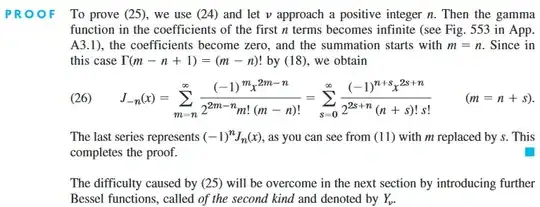I am trying to understand conceptually the linear dependence of $J_{-n}(x)$ and $J_{n}(x)$. Here, $n$ is an integer and $\nu$ is a non-integer. I understand that for $\nu$, we get two linearly in-dependent solutions. But what happens in case of $n$? How does $n$ lead to this dependence (25)? $$J_{-n}(x) = (-1)^{n}J_{n}(x)\tag{25}$$
In Advanced Engineering Mathematics, Kreyszig explains this behaviour by using the formula for $\nu$: $$J_{-\nu}(x) =x^{-\nu}\sum _{m=0}^{\infty }{\frac {(-1)^{m} x^{2m}}{2^{2m-\nu}m!\Gamma (m-\nu+1)}}\tag{24}$$
This is the screenshot of the proof of the dependency:

Can someone please explain how this proof comes about? I am specifically interested in the behaviour of the gamma function in the denominator, in case of $n$.
I read Prove Bessel functions of the first kind of integer order are linearly dependent from the gamma function form, but my original doubts still remain. I can understand the shifting of summation indices.